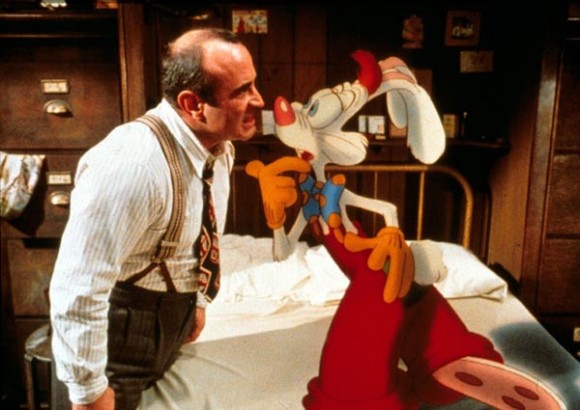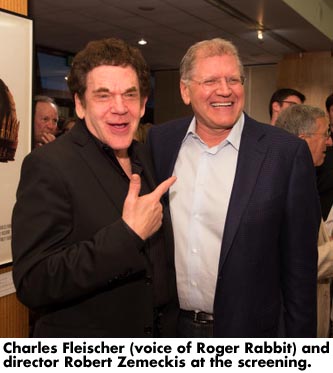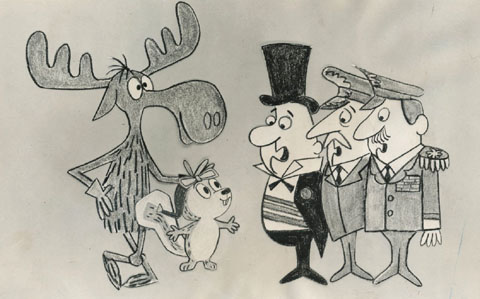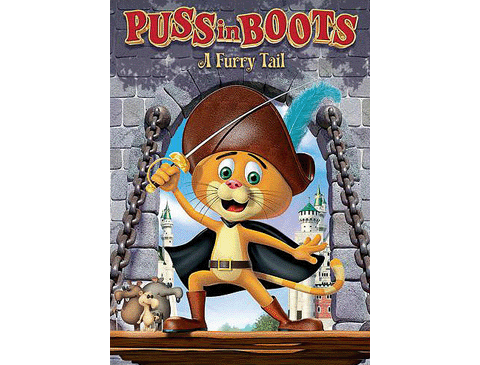Finding the perfect book for the beloved animation fan in your life can be a big challenge, but these gift-book ideas will inform and inspire anyone who loves animation and drawing.
Add a CommentViewing: Blog Posts Tagged with: Darrell Van Citters, Most Recent at Top [Help]
Results 1 - 9 of 9
Blog: Cartoon Brew (Login to Add to MyJacketFlap)
JacketFlap tags: Tante Hilda!, Folimage, Garry Apgar, Hermina Dodalova, Irena Dodalova, Karel Dodal, Books, Mickey Mouse, Criterion, Gustave Doré, John Canemaker, Criterion Collection, Jay Ward, Little Nemo, Winsor McCay, Michael Barrier, Darrell Van Citters, Masaaki Yuasa, Add a tag
Blog: Cartoon Brew (Login to Add to MyJacketFlap)
JacketFlap tags: Advertising, Michelle Obama, dreamworks, DreamWorks Animation, Darrell Van Citters, Penguins of Madagascar, Renegade Animation, Steve Hickner, Add a tag
As DreamWorks Animation CEO Jeffrey Katzenberg knows, there's lot of benefits to being President Obama's BFF.
Add a CommentBlog: Cartoon Brew (Login to Add to MyJacketFlap)
JacketFlap tags: Classic, Paul Reubens, Mike Gabriel, Darrell Van Citters, Who Framed Roger Rabbit, Chris Buck, John Culhane, Marc Sturdivant, Miki Giaimo, Add a tag
"Who Framed Roger Rabbit" was one of the most seminal animated projects of the last thirty years, but few people are aware of the long gestation of the project.
Add a CommentBlog: Cartoon Brew (Login to Add to MyJacketFlap)
JacketFlap tags: John Lasseter, Tim Burton, Frank Thomas, Joe Ranft, Glen Keane, CalArts, Brad Bird, Darrell Van Citters, John Musker, Ron Clements, California Institute of the Arts, Untold Tales, The Fox and the Hound, Art Stevens, Brian McEntee, Jim Mitchell, Mike Giamo, Sue Mantel de Sico, Tad Stones, Add a tag
New chapters of Mouse in Transition will be published every Friday on Cartoon Brew. It is the story of Disney Feature Animation—from the Nine Old Men to the coming of Jeffrey Katzenberg. Ten lost years of Walt Disney Production’s animation studio, through the eyes of a green animation writer. Steve Hulett spent a decade in Disney Feature Animation’s story department writing animated features, first under the tutelage and supervision of Disney veterans Woolie Reitherman and Larry Clemmons, then under the watchful eye of young Jeffrey Katzenberg. Since 1989, Hulett has served as the business representative of the Animation Guild, Local 839 IATSE, a labor organization which represents Los Angeles-based animation artists, writers and technicians. Read Chapter 1: Disney’s Newest Hire Read Chapter 2: Larry Clemmons Read Chapter 3: The Disney Animation Story Crew Read Chapter 4: And Then There Was…Ken! Read Chapter 5: The Marathon Meetings of Woolie Reitherman Read Chapter 6: Detour into Disney History Read Chapter 7: When Everyone Left Disney Read Chapter 8: Mickey Rooney, Pearl Bailey and Kurt Russell “Chief has to DIE,” Ron Clements said. “The picture doesn’t work if he just breaks his LEG. Copper doesn’t have enough motivation to hate the fox.” Ron looked at me intently, shaking his head. He was a supervising animator on The Fox and the Hound, and was just then in the process of making a jump into the story department. He was something of a perfectionist and (for some reason) wanted the story to be better. Ron had worked for a season at Hanna-Barbera and then entered the Disney training program, apprenticing with veteran animator Frank Thomas. Within a decade he would be co-directing Disney’s breakout blockbuster The Little Mermaid, but at this moment he was unhappy with the story arc of The Fox and the Hound. “I agree with you, Ron,” I said. “Agree completely. But do you think Art Stevens will buy a change like that?” “I don’t know. But we have to try. The picture needs to be stronger.” The Fox and the Hound had a three-act structure. The second act had the fox, Tod, involved with a railroad accident. The old dog Chief gets knocked off a tall bridge by a thundering locomotive, and Tod gets unfairly blamed for the accident. Chief dies in the book on which the movie is based, but in the Disney version, the elderly dog only suffers a broken leg. Even so, Copper (the young bloodhound) angrily vows revenge against his friend Tod. Ron and most of the younger story crew thought Copper’s anger and lust for revenge was several clicks over the top, considering Tod’s minor sin. So Ron and the rest of us pleaded the case to the lead director: “Please let’s have Chief DIE.” Art was skittish about it, and said no. No surprise there. So the same argument was hauled upstairs to Disney’s management, with the same reaction: “You can’t kill off a lovable central character! Children will FREAK OUT! Parents will hate us! WE’LL GET LETTERS!!” Neither tearful pleas nor the example of Bambi’s mother catching a bullet could change the directors’ or the top brass’s minds. They wouldn’t kill Chief, and that was final. Ron Clements was not a guy who easily took “No” for an answer, but after a protracted campaign, he dropped the issue. Arguing was as pointless as jousting with windmills. (I had dropped the issue earlier. I am not a big believer in banging my head against hard, thick walls.) But it was one more point of dissatisfaction between the recently-arrived Young Turks and the Disney Animation establishment. The old timers from the 1930s were gone, but the generation that had rolled in during the 1940s and 1950s was finally holding the tiller, and they were bound and determined not to cede their newly acquired power and leverage to a bunch of goddamn kids in their goddamn twenties. Many of the “kids” were from California Institute of the Arts, the Disney-funded college in Valencia, California that served as a training ground for a lot of the animation industry. Walt Disney Productions had, in recent years, skimmed off the cream of the CalArts crop, and recent grads like John Musker, Henry Selick, Brian McEntee, Bruce Morris, Joe Ranft, Mikes Cedeno, Mike Giamo, Tim Burton, Jerry Rees, and an ebullient CalArts star named John Lasseter (among numerous others) populated the animation building. A 1980 volleyball game between the Disney producers and artists. The color commentary and play-by-play by John Musker reveals the underlying tensions between the two camps. Video by Randy Cartwright. Most of the CalArts group groused about the old-timers’ stodgy, moldy fig attitudes, and the stodgy, moldy fig product that resulted therefrom. They had been against the Bluth forces; now they chafed against the veterans’ tightly-held reins. Brad Bird had already gotten his ass fired for making his gripes too loud and too public, but the general mood of frustration and desire to try something fresh, new, and different continued. Even with the bad feelings, various CalArts graduates were being groomed for better things. Early on, John Musker jumped on a career track pointed toward director. John Lasseter was assigned to different projects in development. Bruce Morris and Joe Ranft quickly worked their way into story development. But the veterans remained territorial…and a touch paranoid. I remember Art Stevens saying, “Who do these pipsqueaks think they ARE?! They’re not geniuses. They can’t come in here and have their way after fifteen minutes!” (Another old-timer told me: “Art spent years in John Lounsbery’s unit as his key assistant. And Art would get furious if artists in their group tried to move up and out. He always wanted everybody to stay where they were, to not change anything. He’d get offended if anybody tried to jump ship.”) Tim Burton, bent over a light board down on the first floor, was becoming known for his very un-Disney character sketches. Joe Ranft, Darrell van Citters, Brian McEntee, Mike Giamo, Jim Mitchell, and …
Add a CommentBlog: Cartoon Brew (Login to Add to MyJacketFlap)
JacketFlap tags: Sam Register, Darrell Van Citters, Renegade Animation, Warner Bros. Animation, Ashley Postlewaite, TV, Cartoon Network, Add a tag
"The Tom and Jerry Show" will premiere Wednesday, April 9th, at 5:30pm (ET/PT) on Cartoon Network. It's being pitched as "a fresh take on the iconic frenemies that preserves the look, core characters and sensibilities of the original theatrical shorts." Unlike the original 6-7 minute theatrical shorts, which were produced during the 1940s-'50s, the new episodes will be 11-minutes each.
Add a CommentBlog: Cartoon Brew (Login to Add to MyJacketFlap)
JacketFlap tags: Glen Keane, Mike Gabriel, Richard Williams, Robert Zemeckis, Andreas Deja, Rich Moore, Darrell Van Citters, Don Hahn, Who Framed Roger Rabbit, Bill Kroyer, Gary K. Wolf, Joanna Cassidy, Tom Wilhite, Events, Classic, John Lasseter, Add a tag

ROSS ANDERSON is currently writing the definitive book about the making of Roger Rabbit, beginning with Gary K. Wolf’s novel and Disney’s early Roger Rabbit development unit, continuing with the production of “Who framed Roger Rabbit”, and through the follow-up shorts, merchandising and theme park presence, and development work on sequels. He wrote this piece exclusively for Cartoon Brew about the 25th anniversary screening of “Roger Rabbit” that took place last week in Los Angeles.
On Thursday evening, April 4th, the Academy of Motion Picture Arts and Sciences hosted the first public screening of the new digital print of Who framed Roger Rabbit. The preparation of the digital print coincides with the release of the 25th anniversary Blu-ray edition of the film, and the Academy hosted a terrific show.
When the tickets were made available on-line they sold out within a day or two. The film was enormously popular when it was released and it has been a touchstone for film and animation enthusiasts ever since. I can’t take credit for the touchstone/Touchstone remark—that came from Rich Moore, director of Wreck-It Ralph, who was the moderator of the panel discussion that followed the film screening.
 The event attendees were polite and mature in their behavior, although many of them hadn’t been born when the film was released. The enthusiasm for the film has some of the earmarks of coltishness, but it is not as though the adoration is a personal ‘find’ and a delight against all reason. There are ample reasons to delight in the film, and everybody has their own joys that they find in it. Mine – is that I had been a life-long animation enthusiast who found it difficult to share my enthusiasm with friends. I was in university when Robin Hood was released. I would have been harassed unmercifully if my interest in Disney animation had become known to my dorm-mates. Who framed Roger Rabbit made animation ‘cool’ again…and it made money, which increased the enthusiasm of the studios. Many people in the animation industry credit the film with ushering in a silver age of feature animation.
The event attendees were polite and mature in their behavior, although many of them hadn’t been born when the film was released. The enthusiasm for the film has some of the earmarks of coltishness, but it is not as though the adoration is a personal ‘find’ and a delight against all reason. There are ample reasons to delight in the film, and everybody has their own joys that they find in it. Mine – is that I had been a life-long animation enthusiast who found it difficult to share my enthusiasm with friends. I was in university when Robin Hood was released. I would have been harassed unmercifully if my interest in Disney animation had become known to my dorm-mates. Who framed Roger Rabbit made animation ‘cool’ again…and it made money, which increased the enthusiasm of the studios. Many people in the animation industry credit the film with ushering in a silver age of feature animation.
Academy member and veteran animation director Bill Kroyer introduced the screening. Bill was a young animator at the Disney studio prior to the first onslaught of CalArts grads, who included John Lasseter, Tim Burton, Brad Bird, Henry Selick, John Musker, Jerry Rees, and Darrell Van Citters. They were all frustrated with how Disney animation was functioning in the early-1980s.
Tom Wilhite, the young Disney Live-Action Studio Head, saw their frustration and did what he could to enable projects that would satisfy their creative juices and keep them at the studio. Aside from John Musker, they were all eventually fired or left the studio of their own accord, but out of that early grouping came Tim Burton’s Vincent and Frankenweenie and John Lasseter’s The Brave Little Toaster, which Wilhite eventually produced, with Jerry Rees directing, as ‘Hyperion Pictures’, after he, too, left Disney. Wilhite also brought Tron to the Disney studio and was responsible for setting up the Roger Rabbit development unit at Disney in 1981, helmed by Darrell Van Citters.
Bill Kroyer was one of the first ‘animators’ to do computer animation. He and Jerry Rees were assigned to the Tron production to work with the early CGI providers. The computer software at that time was not intuitive at all, so there was more hand-drawn ‘logistical guidance’ for the programmers than most people realize. That was Bill and Jerry. Their involvement also fired up John Lasseter’s interest in computer animation. The Brave Little Toaster was intended to be the first full length CGI animated feature.
Tron was released in 1982, at a time that the Darrell Van Citters’ Roger Rabbit development unit was getting into full swing. Screenwriters Peter Seaman and Jeffrey Price had just come off of Trenchcoat, a Disney mystery/comedy, and Wilhite assigned them to prepare a screenplay for Roger Rabbit. At that time Wilhite also sent memos to Darrell and Marc Stirdivant, the Disney house producer assigned to the development unit, to scoop up Bill Kroyer, Jerry Rees, John Lasseter, Ron Clements, Randy Cartwright, Mike Gabriel, and Glen Keane for the Roger Rabbit unit. Other things were happening at the studio, and soon most of those people were gone… but wouldn’t that have been something?
Back to the screening – Bill Kroyer called out many of the attendees who had been instrumental in making the film. This list isn’t exhaustive, but those who did stand up included voice actors Charles Fleischer (Roger Rabbit, Benny the Cab and others), June Foray (Lena Hyena), and Tony Anselmo (Donald Duck), animators Andreas Dejas and Nik Ranieri, screenwriters Seaman and Price, editor Artie Schmidt, London studio manager Max Howard, producers Steve Starkey and Don Hahn, and, of course, director Bob Zemeckis.
The film screening was wonderful. The digital print was clear and fresh and the colors popped out at you. Not having seen the film on the big screen for twenty-five years, I found it difficult to discern whether the viewing pleasure was due to anything particular associated with the digital print or simply that I was sharing the big screen experience with a room full of similarly enthusiastic viewers. The quality aspects of the digital restoration were being hotly debated within knots of people after the screening was over.
A panel discussion followed the screening. It was hosted by Rich Moore and included Peter Seaman, Jeffrey Price, Andreas Deja, Charles Fleischer, Joanna Cassidy, Steve Starkey, Bob Zemeckis, and Don Hahn. There were many reminiscences from the production. Most of them were well known to the real Roger Rabbit enthusiasts, but the ones who resonated the most for me were those that put the ‘25-years’ into perspective. We have heard about Who framed Roger Rabbit having way more special effects than Star Wars, but it was also one of the last of the great ‘optical’ effects films. It was a different era.
Zemeckis reminisced that, “we had FedEx and ¾” tape – we had technology by the tail.” He spoke about the first finished animation that came over from the London studio unit. It was the portion of the introductory Something Cookin’ cartoon in which the chili sauce falls off the shelf in Roger’s kettle-head. The British animators spelled ‘chili’ in the British manner, with two l’s (‘chilli’). The scene had to be completely re-animated.
In the scene which the camera trucks over the newspaper headlines showing the Toon cases solved by Valiant & Valiant on Eddie’s desk, the London studio had used the banners of LA newspapers of the time (1947), without having asked permission of the newspapers. One newspaper ended up refusing permission to use their banner – and this complicated scene had to be completely re-shot. Another anecdote was that Paul Newman had been considered for the role of Eddie Valiant. Charles Fleischer immediately shot back that Judge Doom would then have had to use ‘dressing’ instead of ‘dip’.
Don Hahn made a call out for Richard Williams, who recently celebrated his 80th birthday. Richard had hoped to attend but was unable to make it. Also, during the panel discussion, it became clear that the presence of Bob Hoskins was greatly missed. He was universally acclaimed for his work on the film. I must say that the greatest benefit that I saw with the digital presentation was in the close-ups on the actors’ faces. There was sublime acting and emotion that contributed enormously to the ‘reality’ of their interaction with the ’toons. We ‘felt’ it and it was an integral aspect of the great ‘conceit’ of the live-action/toon combination, but the subliminal effects were often lost in the chaos of the action. In this viewing, they popped out at me.

It was a great night. Following the conclusion of the panel discussionm, the many Roger Rabbit production participants reunited on stage to catch up on 25 years. The ‘celebrities’ amongst them were cornered for autographs, and the ‘no photography’ policy of the Academy theater was completely thrown out the window as the hundreds of cameras that were spirited into the theater finally came out.
A group shot was hastily organized and there were many more Roger Rabbit alumni present than had been called out during the evening’s introduction. I counted at least twenty-five alumni. I had the pleasure of speaking to many of them and seeing several of them the next day. It was a special night for Roger Rabbit fans and a special night for those who were involved in making it.
Add a CommentBlog: Cartoon Brew (Login to Add to MyJacketFlap)
JacketFlap tags: Books, TV, Jay Ward, Darrell Van Citters, Add a tag

Animator Darrell Van Citters is following up his most-excellent making of Mr. Magoo’s Christmas Carol book with a new book on The Art of the Jay Ward Studio. As Ward employed many ex-UPA artists, Van Citters uncovered much Ward material researching his Magoo book, realizing that Ward “more than any other studio, tried to keep ‘funny’ alive in TV animation.” Apparently Classic Media and the Ward estate have given their blessing on the project.
Van Citters is quick to point out that his book won’t be another history of the Jay Ward studio – Keith Scott’s thorough examination of the Jay Ward studio, The Moose That Roared, “has already covered that topic and covered it exceptionally well. This is meant to be a visual encyclopedia of the art created by some of the industry’s most talented designers and boarders within the context of TV animation’s golden age”.
Van Citters is putting out the call to any and all collectors of Jay Ward original art, soliciting scans of their pieces for use in the book “in order to make it as complete as possible. This call includes original storyboards, model sheets, layouts, cels, backgrounds, pitch art for unsold pilots, promotional art, ad art, the Bullwinkle comic strip and comics, etc. I realize that much of the early Ward production work was done in Mexico making it extremely difficult to locate, if in fact it still exists.” If you’re a collector of Jay Ward production art or know someone who is, or know family members of artists who worked at Jay Ward, contact Darrell via his website. He’s hoping to have this book published next year. If it’s half as good as his previous volume, we’re in for a treat!
Add a CommentBlog: Cartoon Brew (Login to Add to MyJacketFlap)
JacketFlap tags: Books, TV, Jay Ward, Darrell Van Citters, Add a tag

Animator Darrell Van Citters is following up his most-excellent making of Mr. Magoo’s Christmas Carol book with a new book on The Art of the Jay Ward Studio. As Ward employed many ex-UPA artists, Van Citters uncovered much Ward material researching his Magoo book, realizing that Ward “more than any other studio, tried to keep ‘funny’ alive in TV animation.” Apparently Classic Media and the Ward estate have given their blessing on the project.
Van Citters is quick to point out that his book won’t be another history of the Jay Ward studio – Keith Scott’s thorough examination of the Jay Ward studio, The Moose That Roared, “has already covered that topic and covered it exceptionally well. This is meant to be a visual encyclopedia of the art created by some of the industry’s most talented designers and boarders within the context of TV animation’s golden age”.
Van Citters is putting out the call to any and all collectors of Jay Ward original art, soliciting scans of their pieces for use in the book “in order to make it as complete as possible. This call includes original storyboards, model sheets, layouts, cels, backgrounds, pitch art for unsold pilots, promotional art, ad art, the Bullwinkle comic strip and comics, etc. I realize that much of the early Ward production work was done in Mexico making it extremely difficult to locate, if in fact it still exists.” If you’re a collector of Jay Ward production art or know someone who is, or know family members of artists who worked at Jay Ward, contact Darrell via his website. He’s hoping to have this book published next year. If it’s half as good as his previous volume, we’re in for a treat!
Add a CommentBlog: Cartoon Brew (Login to Add to MyJacketFlap)
JacketFlap tags: Feature Film, Darrell Van Citters, Add a tag

What fresh hell is this?
From the people that brought you Chop Kick Panda, here’s a new 45-minute, direct-to-dvd Puss in Boots knockoff done in the style of a Jay Ward Fractured Fairy Tale. Darrell Van Citters (Renegade Animation) explains:
“The cover is dreadful. The cover will drive people away. I only directed it, but I worked with the writer to make sure he didn’t write anything that couldn’t be executed for more than a $1.98. This company is so cheap they don’t even give us comps, I had to order it on Amazon, myself.”
And you can order it on Amazon too – for $6.69. It actually looks like fun… here’s a sample clip:
Cartoon Brew: Leading the Animation Conversation |
Permalink |
3 comments |
Post tags: Darrell Van Citters


